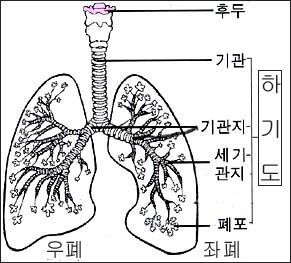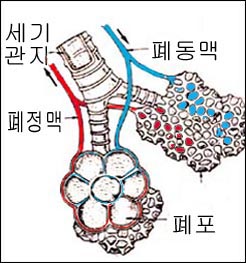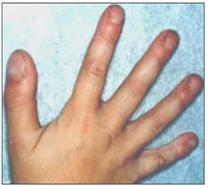객혈(각혈), Hemoptysis
객혈의 개요
-
하기도–후두, 기관, 기관지, 세기관지, 폐 등에서 나온 피(혈액이나 혈담)를 밭아 내는 징후를 객혈이라 한다.
-
위장 관에서 난 피나 피 석긴 구토 물을 뱉어 내는 징후를 토혈(Hematemesis)이라 한다.
-
소아청소년들이 여러 자지 원인으로 객혈을 가끔 경험한다. 비강에서 난 피나 구강이나 인두 강에서 난 피를 뱉어 낼 때 피가 하기도에서 난 객혈로 오진할 수 있다.
-
때로는 객혈과 토혈을 쉽게 감별할 수 없다.
-
뱉은 피 속에 거품이 섞여 있으면 객혈일 가능성이 더 많다.
-
뱉은 피 색이 검붉거나 짙은 갈색일 때, 또는 뱉은 핏속에 음식물 찌꺼기가 섞어 있을 때는 토혈일 가능성이 더 많다.
-
기침하면서 밭은 피는 각혈일 가능성이 더 있다.
객혈의 원인

그림 5. 하기도와 폐.
Copyrightⓒ 2011 John Sangwon Lee, MD., FAAP

그림 6. 폐포와 모세기관지(세기관지).
Copyrightⓒ 2011 John Sangwon Lee, MD., FAAP

사진 1-174. 정상 가슴 X선 사진.
Copyright ⓒ 2011 John Sangwon Lee, MD., FAAP

사진 1-175. 만성 폐병이나 기관지 확장증 등으로 곤봉상지(곤봉 손가락)가 손가락끝 마디에 생길 수 있다.
Copyright ⓒ 2011 John Sangwon Lee, MD., FAAP
-
객혈의 원인은 많다.
-
소아청소년들의 객혈의 원인 중 가장 흔한 원인은 기관지염이다.
-
기관지염의 원인 중 가장 흔한 원인은 급성 바이러스 기관 기관지염이다.
-
그 다음으로 소아청소년들의 각혈의 흔한 원인은 박테리아 폐렴이나 폐결핵 등 호흡기 감염병이다.
-
객혈이 다른 여러 종류의 폐 질환으로도 생길 수 있다.
-
그 외 기관 내 이물이나
-
기관지 내 이물,
-
기관절개 기도,
-
기관 기관지 폐 선천성 기형,
-
기관 기관지 내 혈관 종,
-
가슴 타박상,
-
호흡기 외과적 진단 치료 후,
-
혈액응고 이상 등으로 객혈이 생길 수 있다.
-
폐디스토마 등 폐 기생충증, 결핵,
-
기관지 종양이나 기관지 농양,
-
폐농양이나 종양,
-
폐기종,
-
기관지 확장증,
-
전이성 폐종양,
-
기관지 선종양 등으로 객혈이 생길 수 있다1- 참조문헌.
-
그 외
객혈의 증상 징후
- 순 피가 기침할 때 소량 나오거나 가래에 섞여 나오는 때가 더 많다.
- 아주 드물게 피가 폐나 기관지 등에서 대량 나올 수 있다.
- 성인의 경우, 1일 200cc 이상 객혈하면 생명에 위험하다.
- 폐나 기관지에서 나오지 않고, 그 외 다른 하기도에서 나오지 않는 피, 즉 진짜 객혈이 아닌 피를 객혈이라 오진할 수 있다. 이런 가짜 객혈을 진짜 객혈보다 사실상 소아들에게서는 더 흔히 볼 수 있다.
- 피를 뱉기 전 구토나 구역질을 먼저 하고 피를 뱉으면 일반적으로 토혈일 가능성이 더 많다.
- 토혈 속에 음식물 찌꺼기가 섞여 있을 수 있다.
- 그러나 객혈 속에는 침이나 거품이 섞여 있는 경우가 더 많다.
- 피를 토하는 경우, 간이나 비장이 부어 있거나 복통이 함께 생길 가능성이 더 많이 있으나 객혈이 있는 경우는 청진기로 가슴을 진찰할 때 비정상 기도 폐 음이 기관이나 기관지 폐에서 생길 수 있고 숨 쉬는 소리가 비정상적으로 적게 들릴 수 있고 드물게는 곤봉상(사진 13 참조) 손가락이 생길 수 있다.
- 이런 여러 징후 증상 진찰 소견 등에 따라 토혈과 객혈을 감별 진단하나 때로는 여러 가지 임상검사를 하지 않고 확실히 진단하기가 어렵다.
객혈의 진단 치료
- 객혈은 증상 징후이지 병명은 아니다.
- 증상 징후 병력 진찰 소견 등을 종합해서 객혈이 있는 것 같으면 필요에 따라 객담과 객혈로 그람 염색 현미경 세균검사, 세균 배양검사를 한다. 상기도나 입 안에서 피가 나는지 알아본다.
- 하기도와 폐 등 가슴 X-선 사진, MRI 검사, CT 스캔 검사 등을 하고, 혈액 응고 선별 검사([부모도 반의사가 되어야 한다-소아가정간호백과]-제1권 소아청소년 응급의료 참조) 등을 총 종합해 진단할 때도 있다.
- 박테리아, 곰팡이, 결핵균, 기생충 등 병원체 세균검사를 필요에 따라 한다.
- 필요에 따라 기관 기관지 내시경 검사로 진단할 수 있다.
- 치료는 원인에 따라 한다.
Hemoptysis (hemoptysis)
Overview of hemoptysis
• Lower respiratory tract – The signs of draining blood (blood or sputum) from the larynx, trachea, bronchi, bronchi, and/or lungs are called hemoptysis.
• Hematemesis is a symptom of spitting up blood or bloody vomit from the gastrointestinal tract.
• Children and adolescents occasionally experience hemoptysis for various reasons. Blood from the nasal passages or blood from the mouth or pharynx can be misdiagnosed as hemoptysis from the lower respiratory tract.
• Sometimes it is not easy to distinguish between hemoptysis and Hematemesis.
• If there is foam in the spit blood, it is more likely to be hemoptysis.
• Hematemesis is more likely when the color of the spit is dark red or dark brown, or when food waste is mixed in the spit.
• When coughing, the field bleeding is more likely to be hemoptysis.
Causes of hemoptysis

Figure 5. Lower respiratory tract and lungs. Copyrightⓒ 2011 John Sangwon Lee, MD., FAAP

Figure 6. Alveoli and capillaries (bronchioles). Copyrightⓒ 2011 John Sangwon Lee, MD., FAAP

Picture 1-174. Normal chest X-ray. Copyright ⓒ 2011 John Sangwon Lee, MD., FAAP

Picture 1-175. Chronic lung disease or bronchiectasis can cause club fingers to develop in the knuckle of the fingertips. Copyright ⓒ 2011 John Sangwon Lee, MD., FAAP
• There are many causes of hemoptysis.
• The most common cause of hemoptysis in children and adolescents is bronchitis.
• The most common cause of bronchitis is acute viral bronchitis.
• The next most common cause of hemoptysis in children and adolescents is respiratory infections such as bacterial pneumonia or pulmonary tuberculosis.
• Hemoptysis can also result from many other lung diseases.
• Foreign bodies in other organs or
• endobronchial foreign body;
• tracheostomy airways;
• bronchopulmonary congenital malformations;
• endobronchial hemangioma;
• chest bruises;
• After respiratory surgical diagnosis treatment,
• Hemoptysis may occur due to blood clotting abnormalities.
• Pulmonary parasitosis, tuberculosis, etc.
• bronchial tumors or bronchial abscesses;
• Lung abscess or tumor;
• emphysema;
• bronchiectasis;
• metastatic lung tumors;
• Hemoptysis may be caused by bronchial adenomas, etc.
Symptoms, signs of hemoptysis
• Pureblood comes out in small amounts when coughing or is more often mixed with sputum.
• Very rarely, a large amount of blood may come out of the lungs or bronchi.
• For adults, it is dangerous to life if more than 200cc of hemoptysis per day.
• Blood that does not come from the lungs or bronchial tubes or from any other lower respiratory tract, that is, blood that is not genuine hemoptysis may be misdiagnosed as hemoptysis. This fake hemoptysis is actually more common in children than real hemoptysis.
• Vomiting or nausea before spitting blood and then spitting blood is usually more likely to be hematemesis.
• Food waste may be mixed in the hemoptysis.
• However, hemoptysis is more often mixed with saliva or foam.
If you vomit blood, you are more likely to have swelling of the liver or spleen, or abdominal pain, but if you have hemoptysis, abnormal airway lung sounds may be produced in the trachea or bronchi and lungs when the chest is examined with a stethoscope, and breathing sounds may not be heard. It may be unusually low audible and, rarely, club-like (see photo 13) fingers may develop.
• Hematemesis and hemoptysis are differentially diagnosed based on these various signs, symptoms, examination findings, etc., but sometimes it is difficult to make a definitive diagnosis without conducting various clinical tests.
Diagnosis and treatment of hemoptysis
• Hemoptysis is a symptom, not a disease name.
• If hemoptysis is suspected based on symptoms, signs, history, and examination findings, sputum and hemoptysis should be used for Gram-stained microscopic bacteriological examination and bacterial culture, if necessary. Look for blood in the upper respiratory tract or mouth.
• Perform chest X-rays, MRI scans, CT scans, etc. of the lower respiratory tract and lungs, and blood coagulation screening tests www.drleepediatrics.com – Refer to Vol. 1 Emergency Medical Care for Children and Adolescents), etc. Sometimes the diagnosis is made collectively.
• Bacteria, mold, tuberculosis bacillus, and parasites are tested as necessary.
• Diagnosis can be made by bronchoscopy if necessary.
• Treatment depends on the cause.
출처 및 참조 문헌 Sources and references
- NelsonTextbook of Pediatrics 22ND Ed
- The Harriet Lane Handbook 22ND Ed
- Growth and development of the children
- Red Book 32nd Ed 2021-2024
- Neonatal Resuscitation, American Academy Pediatrics
- Pediatric Nutritional Handbook American Academy of Pediatrics
- 소아가정간호백과–부모도 반의사가 되어야 한다, 이상원 저
- The pregnancy Bible. By Joan stone, MD. Keith Eddleman, MD
- Neonatology Jeffrey J. Pomerance, C. Joan Richardson
- Preparation for Birth. Berverly Savage and Dianna Smith
- 임신에서 신생아 돌보기까지. 이상원
- Breastfeeding by Ruth Lawrence and Robert Lawrence
- www.drleepediatrics.com 제1권 소아청소년 응급 의료
- www.drleepediatrics.com 제2권 소아청소년 예방
- www.drleepediatrics.com 제3권 소아청소년 성장 발육 육아
- www.drleepediatrics.com 제4권 모유,모유수유, 이유
- www.drleepediatrics.com 제5권 인공영양, 우유, 이유식, 비타민, 미네랄, 단백질, 탄수화물, 지방
- www.drleepediatrics.com 제6권 신생아 성장 발육 육아 질병
- www.drleepediatrics.com제7권 소아청소년 감염병
- www.drleepediatrics.com제8권 소아청소년 호흡기 질환
- www.drleepediatrics.com제9권 소아청소년 소화기 질환
- www.drleepediatrics.com제10권. 소아청소년 신장 비뇨 생식기 질환
- www.drleepediatrics.com제11권. 소아청소년 심장 혈관계 질환
- www.drleepediatrics.com제12권. 소아청소년 신경 정신 질환, 행동 수면 문제
- www.drleepediatrics.com제13권. 소아청소년 혈액, 림프, 종양 질환
- www.drleepediatrics.com제14권. 소아청소년 내분비, 유전, 염색체, 대사, 희귀병
- www.drleepediatrics.com제15권. 소아청소년 알레르기, 자가 면역질환
- www.drleepediatrics.com제16권. 소아청소년 정형외과 질환
- www.drleepediatrics.com제17권. 소아청소년 피부 질환
- www.drleepediatrics.com제18권. 소아청소년 이비인후(귀 코 인두 후두) 질환
- www.drleepediatrics.com제19권. 소아청소년 안과 (눈)질환
- www.drleepediatrics.com 제20권 소아청소년 이 (치아)질환
- www.drleepediatrics.com 제21권 소아청소년 가정 학교 간호
- www.drleepediatrics.com 제22권 아들 딸 이렇게 사랑해 키우세요
- www.drleepediatrics.com 제23권 사춘기 아이들의 성장 발육 질병
- www.drleepediatrics.com 제24권 소아청소년 성교육
- www.drleepediatrics.com 제25권 임신, 분만, 출산, 신생아 돌보기
- Red book 29th-31st edition 2021
- Nelson Text Book of Pediatrics 19th- 21st Edition
- The Johns Hopkins Hospital, The Harriet Lane Handbook, 22nd edition
- 응급환자관리 정담미디어
- Pediatric Nutritional Handbook American Academy of Pediatrics
- 소아가정간호백과–부모도 반의사가 되어야 한다, 이상원 저
- The pregnancy Bible. By Joan stone, MD. Keith Eddleman, MD
- Neonatology Jeffrey J. Pomerance, C. Joan Richardson
- Preparation for Birth. Beverly Savage and Dianna Smith
- 임신에서 신생아 돌보기까지. 이상원
- Breastfeeding. by Ruth Lawrence and Robert Lawrence
- Sources and references on Growth, Development, Cares, and Diseases of Newborn Infants
- Emergency Medical Service for Children, By Ross Lab. May 1989. p.10
- Emergency care, Harvey Grant and Robert Murray
- Emergency Care Transportation of Sick and Injured American Academy of Orthopaedic Surgeons
- Emergency Pediatrics A Guide to Ambulatory Care, Roger M. Barkin, Peter Rosen
- Quick Reference To Pediatric Emergencies, Delmer J. Pascoe, M.D., Moses Grossman, M.D. with 26 contributors
- Neonatal resuscitation Ameican academy of pediatrics
- Pediatric Nutritional Handbook American Academy of Pediatrics
- Pediatric Resuscitation Pediatric Clinics of North America, Stephen M. Schexnayder, M.D.
-
Pediatric Critical Care, Pediatric Clinics of North America, James P. Orlowski, M.D.
-
Preparation for Birth. Beverly Savage and Dianna Smith
-
Infectious disease of children, Saul Krugman, Samuel L Katz, Ann A.
- 제4권 모유, 모유수유, 이유 참조문헌 및 출처
- 제5권 인공영양, 우유, 이유, 비타민, 단백질, 지방 탄수 화물 참조문헌 및 출처
- 제6권 신생아 성장발육 양호 질병 참조문헌 및 출처
- 소아과학 대한교과서
Copyright ⓒ 2014 John Sangwon Lee, MD., FAAP
“부모도 반의사가 되어야 한다”-내용은 여러분들의 의사로부터 얻은 정보와 진료를 대신할 수 없습니다.
“The information contained in this publication should not be used as a substitute for the medical care and advice of your doctor. There may be variations in treatment that your doctor may recommend based on individual facts and circumstances.
“Parental education is the best medicine.